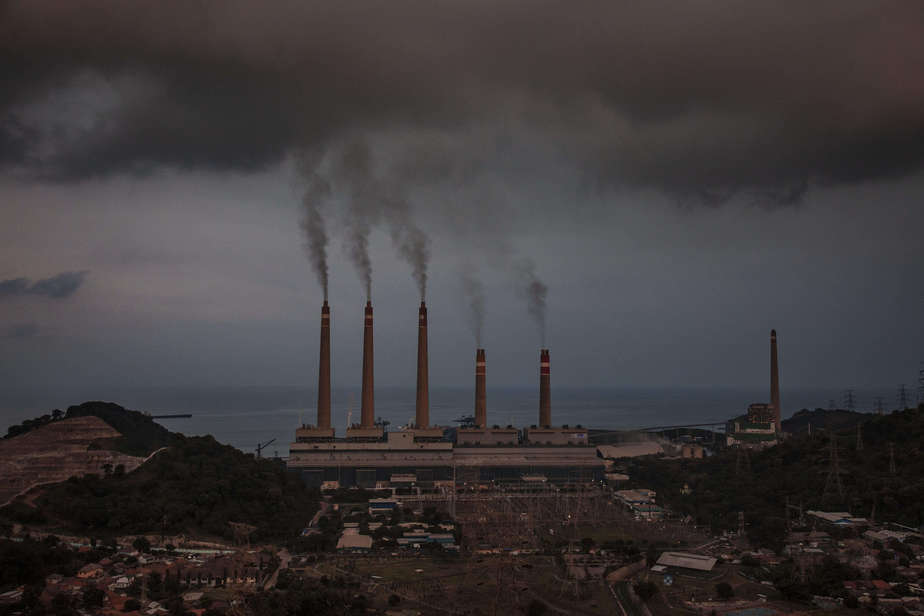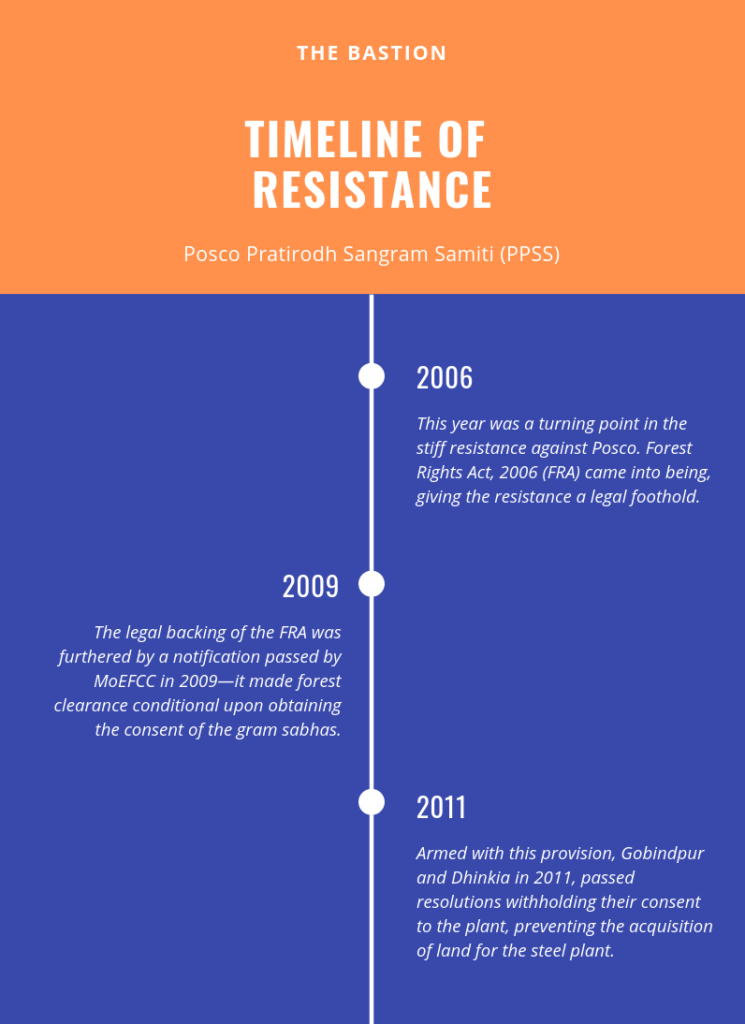Written by Arpitha Kodiveri
Nestled within the mangroves along the coast of the Bay of Bengal are three panchayats of Gobindpur, Dhinkia, and Nuagaon. Bordered by the rich mangrove forests and the coast in Paradeep, Odisha these stretches of sandy forests are lush and home to diverse fruit orchards and betel-vine plantations. A unique mesh of coast and forest these areas are living ecosystems that support the livelihood of this agrarian community. In the adjacent coastal Paradip, an integrated steel plant envisaging a production of 12 million tonnes of steel was proposed.
For the past 14 years, the communities here have been a part of a struggle of resistance, undemocratic decisions and unjust land acquisition. Most recently, their story has met with a new turn. Where initially the Korea-based Pohang Steel Company (Posco) was granted forest clearance, on August 16, 2019, Ministry of Environment, Forests and Climate Change (MoEFCC) transferred this to a different company, JSW. A step that bypassed local consultations, it only echoes the communities’ concerns of the past. Brahmaro Das, a local resident and activist says, “The community will continue to struggle against such unjust acquisition.”
Why did the community resist?
Communities of Dalit and agrarian forest-dwellers that reside here had thrived on an agrarian economy based on the sale of betel leaves and cashew, among other crops. So when the state of Odisha signed an MoU with Posco in 2005, it was met with resistance. Many had feared not just a loss of their fertile lands, but also that it would not generate as many jobs. “We employ a minimum of forty people in our fields and they come from neighbouring villages too, I am quite sure that the steel plant will not generate as many jobs,” Prakash Jena a local.
In fact, the 2001 census showed that 22,000 members from the local community would be directly affected and 30,000 whose livelihood will be indirectly affected. With the community’s concern not reflecting in the decision of the state government, they united against the banner of Posco Pratirodh Sangram Samiti (PPSS). Prakash Jena and Brahmaro Das are also activists with the same.
After the panchayats withheld their consent, the state government retaliated. The District Collector issued a letter stating that no Other Traditional Forest Dwellers (OTFD) in the areas existed where land was being acquired. FRA hence, he further stated, did not apply here. While the local communities continued to assert their rights, Jairam Ramesh, the then minister of MoEFCC, in his speaking order, granted the final forest clearance, a vast extent of 1253 hectares of forest land. He based this on Odisha’s competency to make decisions on the local situation, and in light of the principles of “cooperative federalism”, the center would defer to the state and its decision. In 2017, the final clearance was granted, but the local conflict remained unresolved.
What a good news to start day. More power to people’s struggle. #Posco #Odisha pic.twitter.com/M5eduq7Wif
— Avinash chanchal (@AvinashChanchal) March 18, 2017
Around the same time, the Mines and Minerals Regulatory Act, 2015 underwent amendments that changed the game for Posco. Captive mines were no longer permitted, which meant that for Posco to access iron ore, they would have to bid in auctions. Posco, then, withdrew from the project.
How did JSW come in the picture?
Over time, members of the community who had sold their land returned to reclaim it, setting up their betel-vine plantations. But just adjacent to these plantations, signs of a new development started to emerge— a boundary wall. The wall demarcates a ‘land bank’ where government owned land is made available for industries. These land banks are supposed to reduce the bureaucratic hurdles that industries have to encounter in the process of land acquisition.
Legally, these land banks are at loggerheads with section 4(8) of FRA, which provides for the land to be returned to the local community if the land has not been used for the designated purpose. “We were given minimal compensation, and the money ran out quite quickly,” says a resident of Nuagaon who had sold her land in the initial phase of acquisition for Posco. “We now need to do something for our livelihood so we have returned to take back our land.”
But the Odisha Industrial and Infrastructure Development Corporation (IDCO) has not let locals reclaim ownership of their lands. IDCO stated that since the land was once acquired by the state, it is now owned by the government.
But if Posco withdrew from the project, for whom was this land bank created? The answer reflects in Forest Advisory Committee’s (FAC) minutes of August 16th, 2019 where the forest clearance granted to Posco has been transferred to a different company, JSW. FAC defended their stance upon legal backing and on years of scrutiny that Posco case was subject to, which they believed made it more efficient to transfer the clearance rather than undergoing a fresh process.
“Extractive capital is predatory by nature; the land was once acquired for the earlier steel plant and we now have JSW coming. It was expected!” narrated a senior activist who has been associated with many struggles across Odisha.
Will concerns be addressed?
The Forest Conservation Act, 1980 allows for such transfer if the land is being provided for the same use and the new user agency agrees to comply with the same conditions of the earlier forest clearance. But some concerns and questions remain unaddressed, keeping one of the most important stakeholders in the shadows: If the minutiae of the project might differ, then how will the same conditions imposed on the earlier forest clearance address new concerns? Where conflict on the ground is still unresolved, how will the interests of the community be accounted for?
The use of mechanisms like land banks and the transfer of forest clearances create a legal façade that conflicts are resolved while unrest exists under its surface.
These mechanisms become counterproductive towards what Acts like FRA for forest land, and The Right to Fair Compensation and Transparency in Land Acquisition, Rehabilitation and Resettlement Act, 2013 (LARR) for revenue land had envisioned doing. While legal mechanisms try their best to minimize the consent process in developmental projects, it only reflects the myopic understanding that dissent is inefficient and reduces the pace with which projects can be cleared. By bypassing consultations from those who are directly impacted by projects, and then suppressing the dissent, conflicts remain unaddressed.
As some members still continue to show their disagreement to the project, it is yet to be seen if JSW functions smoothly here. Till then, the community still awaits answers: will the community be adequately compensated? Will they be resettled outside and will they receive jobs in the steel plant? How will this steel plant make up for the losses that they will incur with the destruction of their betel-vine plants? But with the shrunk space for negotiations they witnessed in the past years, they are uncertain of how much longer it would be before they found answers.
Featured image is for representational purposes.
Image Courtesy: ‘A Deadly Double Standard’, Greenpeace.







